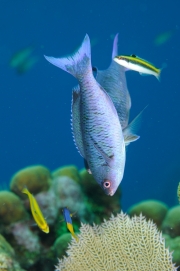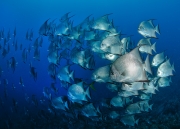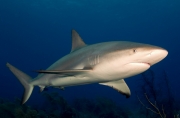I’ve had several occasions to dive in Honduras from Laguna Beach Resort on Utila. I had the chance to dive from the Utila Aggressor II with Captain Nestor Vidotto and his great crew, but since this trip the Aggressor II has been sold to a private owner and no longer is part of the Aggressor fleet. Having said this, the diving was great and opened up some new territories and some great dive sites around both Utila and Roatan – two of the Bay Islands of Honduras! The third Bay Island is Guanaja. It was a special treat to get to finally dive the Coco’s Sea Mounts. These seamounts lie between Utila and Roatan and are tough to reach via the day dive boats. I was thrilled to hang out and watch this large school of spadefish. This huge school was in total harmony and circled the area in a rhythmic pattern about 60 feet down and just off the mount. There are plenty of corals and colorful fish life, and I recommend making numerous dives if you have the opportunity to get to these seamounts.
Another of my favorite spots was Black Hills where there is an abundance of pelagics along with smaller critters tucked into hiding spots all along the reef. This Titan triggerfish was in a very secure hiding place, but I was very careful to make sure that this Titan was not nesting – they can be extremely aggressive and have attacked and injured divers who get too close to their nest. On the benign side, I am always amazed by the beauty and abundance of bluebell tunicates in the Honduran waters. Their color stands out all along the reefs. Symbiosis abounds on both the Black Hill’s and the Coco’s Sea Mount dive sites. If you take a few minutes to stop and observe, you will see cleaning stations everywhere. This small snapper had just moved into a vertical position to receive cleaning from incoming wrasses. Drums, indigo hamlets, angelfish, turtles, filefish, and basslets add both color and variety to both of these great dive sites.
If you have never been diving with sharks, I recommend Cara a Cara – “face to face” – for your first shark experience. The Caribbean Reef sharks “know” that your dive boat and divers are coming. Divers can position themselves against a wall about 60 feet deep and watch these graceful and majestic sharks circle the
area. These elegant sharks are enticed with small buckets of fish to keep them attracted to the area for some great observations and photo opportunities. Sharks are a keystone predator and critical to the balance in the ocean’s food chain. They are magnificent animals that continue to be demonized and destroyed by such brutal practices as shark finning. California just recently banned this practice. For more information and proactive information on shark finning and shark populations, I would suggest checking out these two websites: Sharkwater and Sharksavers
If you have never experienced diving through fabulous crevasses and tunnels, Mary’s Place is “the” place. The swim-through is filled with healthy sponges, fans, schools of silversides, and great fish life.. With the respect to the diver behind you and to the life attached to the walls, one must be very careful to not kick up sediments with your fins or come into contact with the walls during the dive. As you complete the dive, you will end up at about 80 feet and can either take another crevice back to the surface or swim around the wall and gradually made your ascent and safety stop.
Staying in Roatan, Eel Garden was another “hot spot.” We chose to dive the shallows and sandy bottom, and observed large schools of squid hovering above and several flounders moving and stopping on the bottom –changing their colors at each stop to blend into their bottom environment using their color changing cells – chromatophores. With both eyes on top of their head, it is fun to be very still and quiet and watch this founder observe and check out its surroundings.
Although I’m not an experienced wreck diver, I found the dive on the El Aquilamost fun. El Aguila – “The Eagle” was sunk in ’97 and sits in three pieces with the deepest part in 100 feet of water. The best part of this dive was seeing the surprise on my dive buddy’s face when one of the many large groupers swam in front of her. These groupers are quite friendly, but they expect some food fish in return! I suspect the Captain Nestor had something to do with attracting this very large grouper my dive buddy. Of course, this grouper swam right in front of my dome port to make it look larger than life!
Speaking of Captain Nestor, my favorite spot was Ted’s Point! It was a thrill to see my first Stargazer – a Southern Stargazer! Captain Nestor knew right were to find this big boy! This was truly an amazing sight! Like the flounder, the stargazer has top mounted eyes with a mouth facing upward (superior mouth) and is a master of camouflage. The stargazer literally buries itself in the sand with only its eyes and mouth barely peeking out of the sand. It then ambushes small prey swimming above. The stargazer is not particularly good looking and perhaps this is a warning for predators. The Southern stargazer should never be touched by divers a it can produce an electrical current that is delivered by an electrical organ.









